Strategic Supply Chain Management Report: Juice Company Strategies
VerifiedAdded on 2020/05/28
|8
|2170
|68
Report
AI Summary
This report provides a strategic analysis of supply chain management for a juice company. It addresses key issues and strategies to improve financial and non-financial performance. The report explores inventory management techniques like fixed safety stock, time-based, and statistical methods to optimize stock levels. It emphasizes the importance of supplier selection using scorecards and proper agreements, alongside production capacity planning and improvement. Additionally, the report discusses enhancing product value through time, quantity, and form utility, along with optimal production policies and demand forecasting methods. Furthermore, the report outlines a risk management framework to mitigate supply chain disruptions, identifying potential risks such as contamination, pandemics, power loss, natural disasters, IT failures, logistics issues, economic forces, and regulatory non-compliance. Strategies to minimize these risks include maintaining safety stock, restricting data access, ensuring data backups, and optimizing production costs.
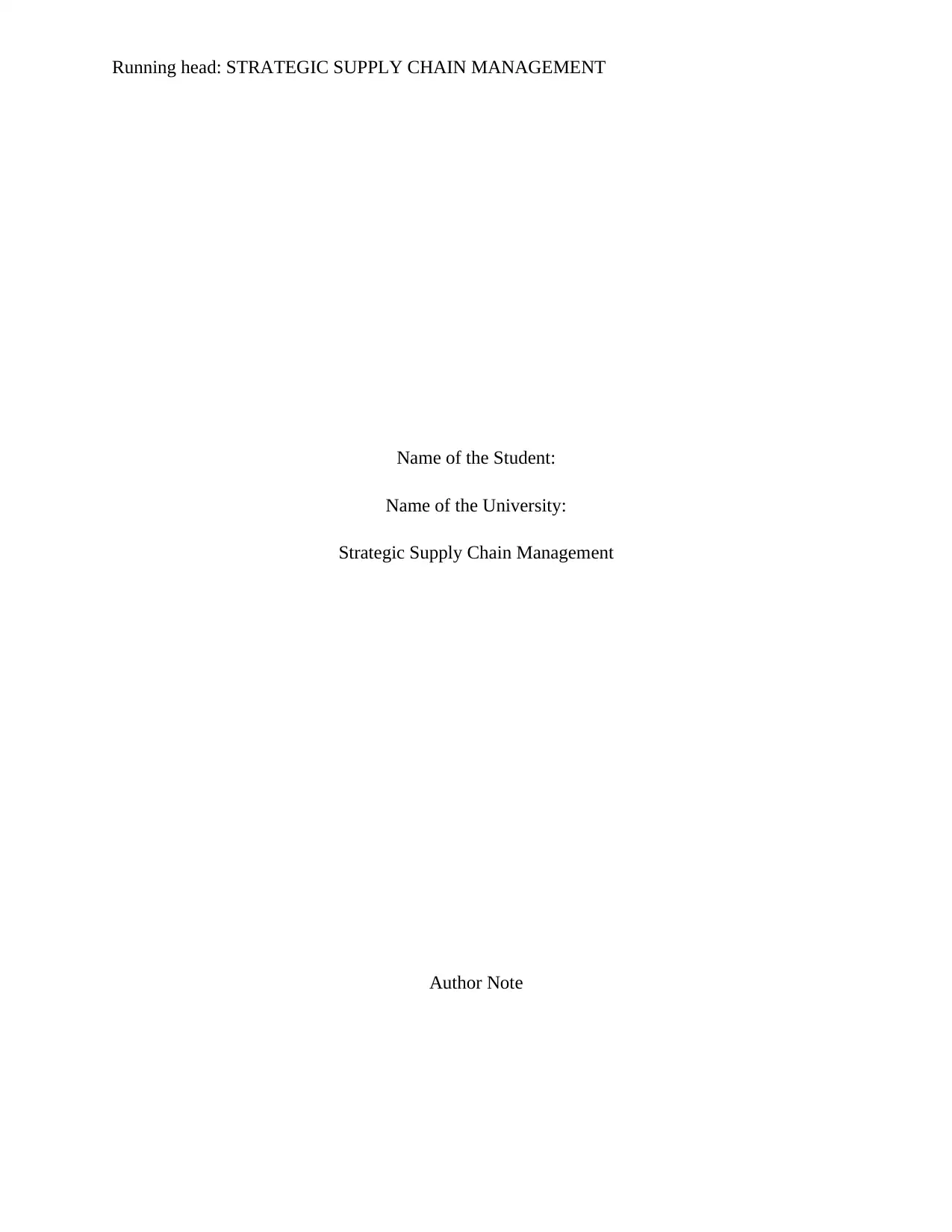
Running head: STRATEGIC SUPPLY CHAIN MANAGEMENT
Name of the Student:
Name of the University:
Strategic Supply Chain Management
Author Note
Name of the Student:
Name of the University:
Strategic Supply Chain Management
Author Note
Paraphrase This Document
Need a fresh take? Get an instant paraphrase of this document with our AI Paraphraser
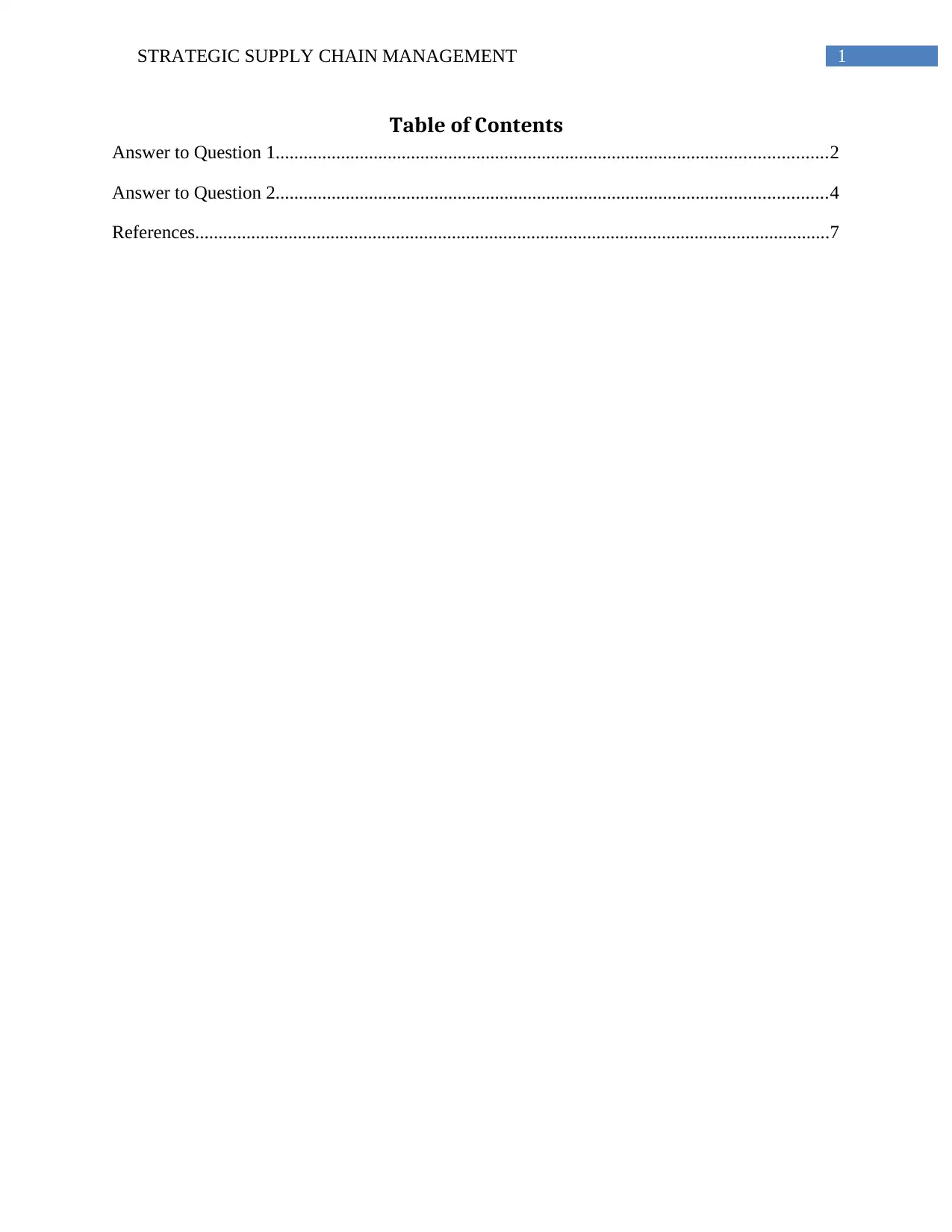
1STRATEGIC SUPPLY CHAIN MANAGEMENT
Table of Contents
Answer to Question 1......................................................................................................................2
Answer to Question 2......................................................................................................................4
References........................................................................................................................................7
Table of Contents
Answer to Question 1......................................................................................................................2
Answer to Question 2......................................................................................................................4
References........................................................................................................................................7
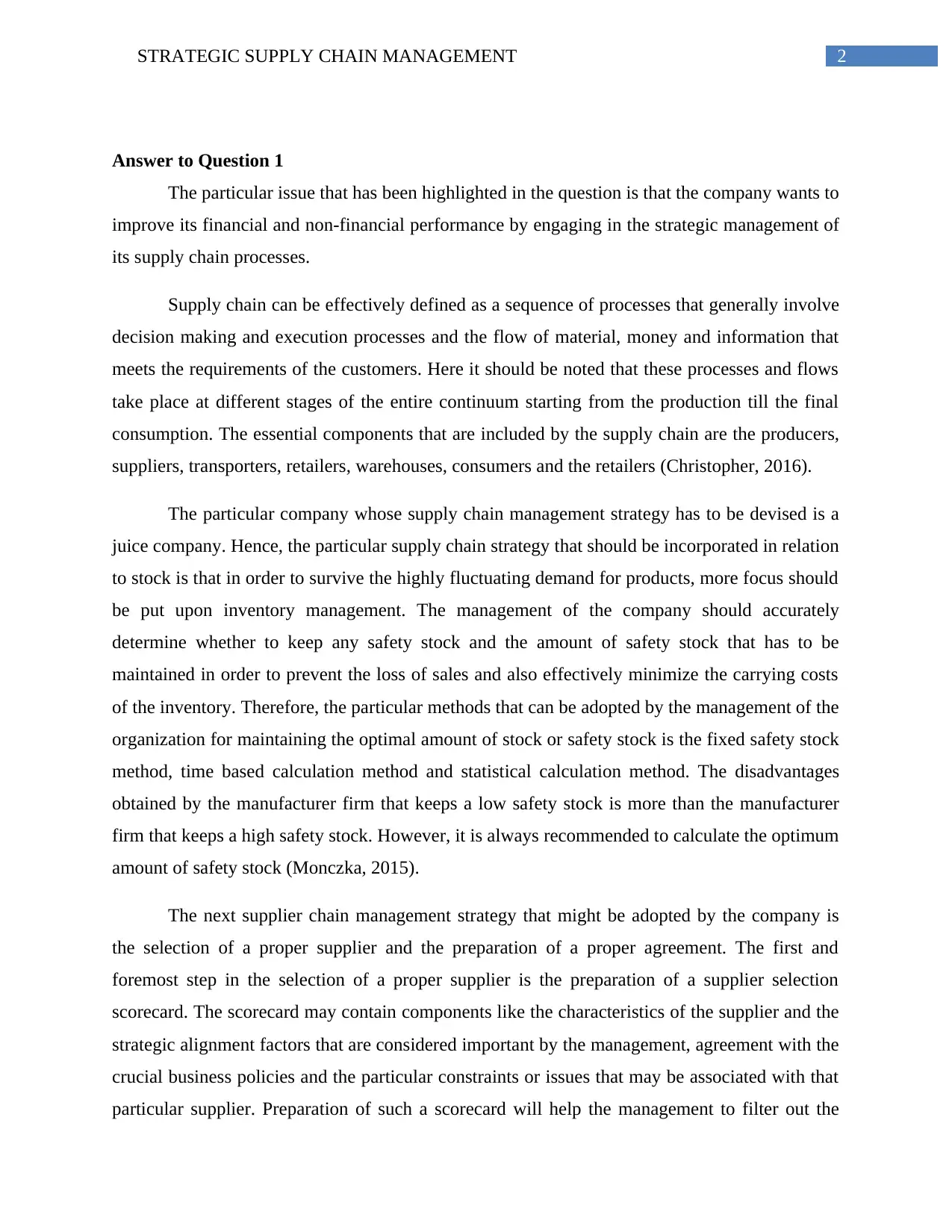
2STRATEGIC SUPPLY CHAIN MANAGEMENT
Answer to Question 1
The particular issue that has been highlighted in the question is that the company wants to
improve its financial and non-financial performance by engaging in the strategic management of
its supply chain processes.
Supply chain can be effectively defined as a sequence of processes that generally involve
decision making and execution processes and the flow of material, money and information that
meets the requirements of the customers. Here it should be noted that these processes and flows
take place at different stages of the entire continuum starting from the production till the final
consumption. The essential components that are included by the supply chain are the producers,
suppliers, transporters, retailers, warehouses, consumers and the retailers (Christopher, 2016).
The particular company whose supply chain management strategy has to be devised is a
juice company. Hence, the particular supply chain strategy that should be incorporated in relation
to stock is that in order to survive the highly fluctuating demand for products, more focus should
be put upon inventory management. The management of the company should accurately
determine whether to keep any safety stock and the amount of safety stock that has to be
maintained in order to prevent the loss of sales and also effectively minimize the carrying costs
of the inventory. Therefore, the particular methods that can be adopted by the management of the
organization for maintaining the optimal amount of stock or safety stock is the fixed safety stock
method, time based calculation method and statistical calculation method. The disadvantages
obtained by the manufacturer firm that keeps a low safety stock is more than the manufacturer
firm that keeps a high safety stock. However, it is always recommended to calculate the optimum
amount of safety stock (Monczka, 2015).
The next supplier chain management strategy that might be adopted by the company is
the selection of a proper supplier and the preparation of a proper agreement. The first and
foremost step in the selection of a proper supplier is the preparation of a supplier selection
scorecard. The scorecard may contain components like the characteristics of the supplier and the
strategic alignment factors that are considered important by the management, agreement with the
crucial business policies and the particular constraints or issues that may be associated with that
particular supplier. Preparation of such a scorecard will help the management to filter out the
Answer to Question 1
The particular issue that has been highlighted in the question is that the company wants to
improve its financial and non-financial performance by engaging in the strategic management of
its supply chain processes.
Supply chain can be effectively defined as a sequence of processes that generally involve
decision making and execution processes and the flow of material, money and information that
meets the requirements of the customers. Here it should be noted that these processes and flows
take place at different stages of the entire continuum starting from the production till the final
consumption. The essential components that are included by the supply chain are the producers,
suppliers, transporters, retailers, warehouses, consumers and the retailers (Christopher, 2016).
The particular company whose supply chain management strategy has to be devised is a
juice company. Hence, the particular supply chain strategy that should be incorporated in relation
to stock is that in order to survive the highly fluctuating demand for products, more focus should
be put upon inventory management. The management of the company should accurately
determine whether to keep any safety stock and the amount of safety stock that has to be
maintained in order to prevent the loss of sales and also effectively minimize the carrying costs
of the inventory. Therefore, the particular methods that can be adopted by the management of the
organization for maintaining the optimal amount of stock or safety stock is the fixed safety stock
method, time based calculation method and statistical calculation method. The disadvantages
obtained by the manufacturer firm that keeps a low safety stock is more than the manufacturer
firm that keeps a high safety stock. However, it is always recommended to calculate the optimum
amount of safety stock (Monczka, 2015).
The next supplier chain management strategy that might be adopted by the company is
the selection of a proper supplier and the preparation of a proper agreement. The first and
foremost step in the selection of a proper supplier is the preparation of a supplier selection
scorecard. The scorecard may contain components like the characteristics of the supplier and the
strategic alignment factors that are considered important by the management, agreement with the
crucial business policies and the particular constraints or issues that may be associated with that
particular supplier. Preparation of such a scorecard will help the management to filter out the
⊘ This is a preview!⊘
Do you want full access?
Subscribe today to unlock all pages.

Trusted by 1+ million students worldwide

3STRATEGIC SUPPLY CHAIN MANAGEMENT
suppliers who do not meet the company criteria thus, facilitating proper selection of the suppliers
(Stadtler, 2015).
The next supply chain strategy that should be adopted by the company is the selection of
the particulars in relation to the production capacities of the company. A turnaround business
strategy in terms of the production capacity would be moving the facility to a country that
operates in low cost, outsourcing selected batch of production through a selected band of
suppliers and balancing the capacity to demand ratio. The production site capacity planning
might also be improved by monitoring the equipment utilization rate, working shifts of the staff
and increasing the storage capacity. The company might make use of an analysis and
optimization software in order to achieve the successful implementation of the strategy
(Bartezzaghi, 2016).
The next supply chain management strategy that may be implemented by the
management of the company is the improvement of the value proposition of the product sold by
the company. The value of the product might be increased by improving the time utility, quantity
utility, form utility of the product. Time utility might be improved by making the product easily
available to the customers. Quantity utility might be improved by ensuring that the right amount
of product that satisfies the demand. Lastly, the form utility of the product might be improved by
changing the essential characteristics of the product (Rushton, Croucher & Baker, 2014).
Next, the supply chain management strategy that might be implemented by business in
order to improve the performance of the company is in regards to the production policy. The
production delivery system should be such that it effectively reduces the overall production and
management cost. The improvement of the production policy might be achieved by the
development of a decision making model. The decision making model that is developed selects
the optimal rate of production in a single state supply chain that has volume flexibility (Rushton,
Croucher & Baker, 2014).
Lastly, the supply chain management strategy that should be implemented in the
company is the utilization of the demand forecasting tool. In the context of the supply chain
management, the major three types of forecasting are supply forecasting, demand forecasting and
price forecast. However, the selected company being a manufacturing company, it would be
suppliers who do not meet the company criteria thus, facilitating proper selection of the suppliers
(Stadtler, 2015).
The next supply chain strategy that should be adopted by the company is the selection of
the particulars in relation to the production capacities of the company. A turnaround business
strategy in terms of the production capacity would be moving the facility to a country that
operates in low cost, outsourcing selected batch of production through a selected band of
suppliers and balancing the capacity to demand ratio. The production site capacity planning
might also be improved by monitoring the equipment utilization rate, working shifts of the staff
and increasing the storage capacity. The company might make use of an analysis and
optimization software in order to achieve the successful implementation of the strategy
(Bartezzaghi, 2016).
The next supply chain management strategy that may be implemented by the
management of the company is the improvement of the value proposition of the product sold by
the company. The value of the product might be increased by improving the time utility, quantity
utility, form utility of the product. Time utility might be improved by making the product easily
available to the customers. Quantity utility might be improved by ensuring that the right amount
of product that satisfies the demand. Lastly, the form utility of the product might be improved by
changing the essential characteristics of the product (Rushton, Croucher & Baker, 2014).
Next, the supply chain management strategy that might be implemented by business in
order to improve the performance of the company is in regards to the production policy. The
production delivery system should be such that it effectively reduces the overall production and
management cost. The improvement of the production policy might be achieved by the
development of a decision making model. The decision making model that is developed selects
the optimal rate of production in a single state supply chain that has volume flexibility (Rushton,
Croucher & Baker, 2014).
Lastly, the supply chain management strategy that should be implemented in the
company is the utilization of the demand forecasting tool. In the context of the supply chain
management, the major three types of forecasting are supply forecasting, demand forecasting and
price forecast. However, the selected company being a manufacturing company, it would be
Paraphrase This Document
Need a fresh take? Get an instant paraphrase of this document with our AI Paraphraser
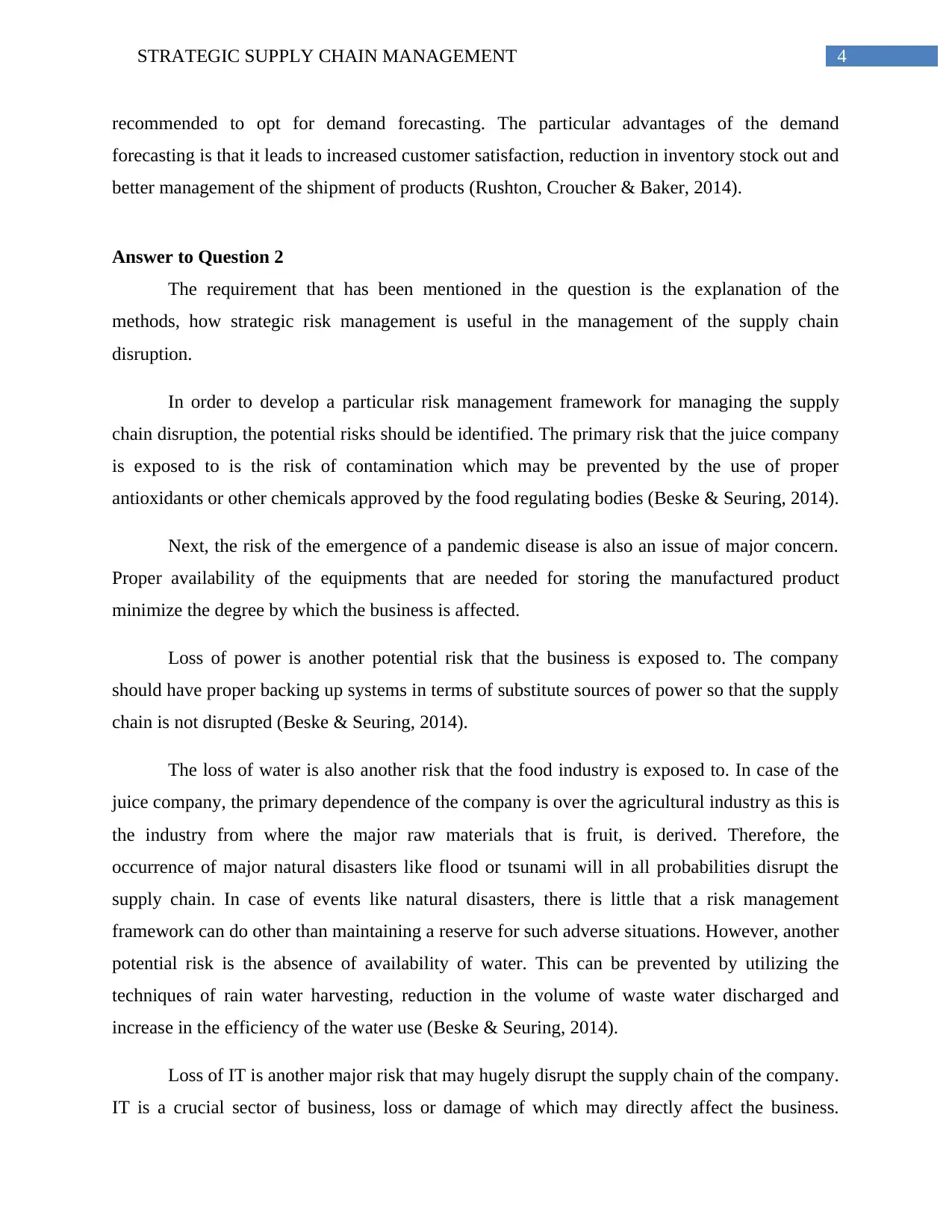
4STRATEGIC SUPPLY CHAIN MANAGEMENT
recommended to opt for demand forecasting. The particular advantages of the demand
forecasting is that it leads to increased customer satisfaction, reduction in inventory stock out and
better management of the shipment of products (Rushton, Croucher & Baker, 2014).
Answer to Question 2
The requirement that has been mentioned in the question is the explanation of the
methods, how strategic risk management is useful in the management of the supply chain
disruption.
In order to develop a particular risk management framework for managing the supply
chain disruption, the potential risks should be identified. The primary risk that the juice company
is exposed to is the risk of contamination which may be prevented by the use of proper
antioxidants or other chemicals approved by the food regulating bodies (Beske & Seuring, 2014).
Next, the risk of the emergence of a pandemic disease is also an issue of major concern.
Proper availability of the equipments that are needed for storing the manufactured product
minimize the degree by which the business is affected.
Loss of power is another potential risk that the business is exposed to. The company
should have proper backing up systems in terms of substitute sources of power so that the supply
chain is not disrupted (Beske & Seuring, 2014).
The loss of water is also another risk that the food industry is exposed to. In case of the
juice company, the primary dependence of the company is over the agricultural industry as this is
the industry from where the major raw materials that is fruit, is derived. Therefore, the
occurrence of major natural disasters like flood or tsunami will in all probabilities disrupt the
supply chain. In case of events like natural disasters, there is little that a risk management
framework can do other than maintaining a reserve for such adverse situations. However, another
potential risk is the absence of availability of water. This can be prevented by utilizing the
techniques of rain water harvesting, reduction in the volume of waste water discharged and
increase in the efficiency of the water use (Beske & Seuring, 2014).
Loss of IT is another major risk that may hugely disrupt the supply chain of the company.
IT is a crucial sector of business, loss or damage of which may directly affect the business.
recommended to opt for demand forecasting. The particular advantages of the demand
forecasting is that it leads to increased customer satisfaction, reduction in inventory stock out and
better management of the shipment of products (Rushton, Croucher & Baker, 2014).
Answer to Question 2
The requirement that has been mentioned in the question is the explanation of the
methods, how strategic risk management is useful in the management of the supply chain
disruption.
In order to develop a particular risk management framework for managing the supply
chain disruption, the potential risks should be identified. The primary risk that the juice company
is exposed to is the risk of contamination which may be prevented by the use of proper
antioxidants or other chemicals approved by the food regulating bodies (Beske & Seuring, 2014).
Next, the risk of the emergence of a pandemic disease is also an issue of major concern.
Proper availability of the equipments that are needed for storing the manufactured product
minimize the degree by which the business is affected.
Loss of power is another potential risk that the business is exposed to. The company
should have proper backing up systems in terms of substitute sources of power so that the supply
chain is not disrupted (Beske & Seuring, 2014).
The loss of water is also another risk that the food industry is exposed to. In case of the
juice company, the primary dependence of the company is over the agricultural industry as this is
the industry from where the major raw materials that is fruit, is derived. Therefore, the
occurrence of major natural disasters like flood or tsunami will in all probabilities disrupt the
supply chain. In case of events like natural disasters, there is little that a risk management
framework can do other than maintaining a reserve for such adverse situations. However, another
potential risk is the absence of availability of water. This can be prevented by utilizing the
techniques of rain water harvesting, reduction in the volume of waste water discharged and
increase in the efficiency of the water use (Beske & Seuring, 2014).
Loss of IT is another major risk that may hugely disrupt the supply chain of the company.
IT is a crucial sector of business, loss or damage of which may directly affect the business.
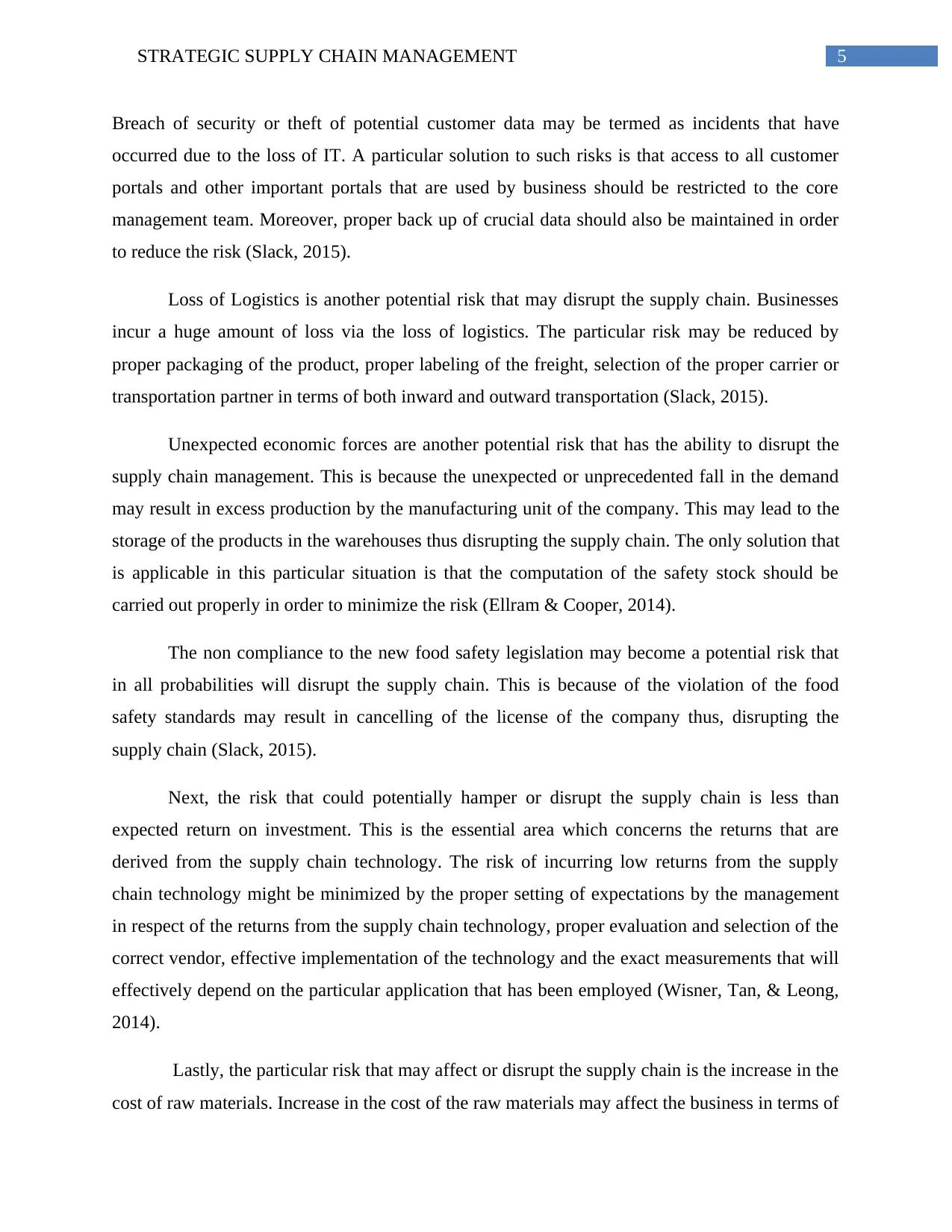
5STRATEGIC SUPPLY CHAIN MANAGEMENT
Breach of security or theft of potential customer data may be termed as incidents that have
occurred due to the loss of IT. A particular solution to such risks is that access to all customer
portals and other important portals that are used by business should be restricted to the core
management team. Moreover, proper back up of crucial data should also be maintained in order
to reduce the risk (Slack, 2015).
Loss of Logistics is another potential risk that may disrupt the supply chain. Businesses
incur a huge amount of loss via the loss of logistics. The particular risk may be reduced by
proper packaging of the product, proper labeling of the freight, selection of the proper carrier or
transportation partner in terms of both inward and outward transportation (Slack, 2015).
Unexpected economic forces are another potential risk that has the ability to disrupt the
supply chain management. This is because the unexpected or unprecedented fall in the demand
may result in excess production by the manufacturing unit of the company. This may lead to the
storage of the products in the warehouses thus disrupting the supply chain. The only solution that
is applicable in this particular situation is that the computation of the safety stock should be
carried out properly in order to minimize the risk (Ellram & Cooper, 2014).
The non compliance to the new food safety legislation may become a potential risk that
in all probabilities will disrupt the supply chain. This is because of the violation of the food
safety standards may result in cancelling of the license of the company thus, disrupting the
supply chain (Slack, 2015).
Next, the risk that could potentially hamper or disrupt the supply chain is less than
expected return on investment. This is the essential area which concerns the returns that are
derived from the supply chain technology. The risk of incurring low returns from the supply
chain technology might be minimized by the proper setting of expectations by the management
in respect of the returns from the supply chain technology, proper evaluation and selection of the
correct vendor, effective implementation of the technology and the exact measurements that will
effectively depend on the particular application that has been employed (Wisner, Tan, & Leong,
2014).
Lastly, the particular risk that may affect or disrupt the supply chain is the increase in the
cost of raw materials. Increase in the cost of the raw materials may affect the business in terms of
Breach of security or theft of potential customer data may be termed as incidents that have
occurred due to the loss of IT. A particular solution to such risks is that access to all customer
portals and other important portals that are used by business should be restricted to the core
management team. Moreover, proper back up of crucial data should also be maintained in order
to reduce the risk (Slack, 2015).
Loss of Logistics is another potential risk that may disrupt the supply chain. Businesses
incur a huge amount of loss via the loss of logistics. The particular risk may be reduced by
proper packaging of the product, proper labeling of the freight, selection of the proper carrier or
transportation partner in terms of both inward and outward transportation (Slack, 2015).
Unexpected economic forces are another potential risk that has the ability to disrupt the
supply chain management. This is because the unexpected or unprecedented fall in the demand
may result in excess production by the manufacturing unit of the company. This may lead to the
storage of the products in the warehouses thus disrupting the supply chain. The only solution that
is applicable in this particular situation is that the computation of the safety stock should be
carried out properly in order to minimize the risk (Ellram & Cooper, 2014).
The non compliance to the new food safety legislation may become a potential risk that
in all probabilities will disrupt the supply chain. This is because of the violation of the food
safety standards may result in cancelling of the license of the company thus, disrupting the
supply chain (Slack, 2015).
Next, the risk that could potentially hamper or disrupt the supply chain is less than
expected return on investment. This is the essential area which concerns the returns that are
derived from the supply chain technology. The risk of incurring low returns from the supply
chain technology might be minimized by the proper setting of expectations by the management
in respect of the returns from the supply chain technology, proper evaluation and selection of the
correct vendor, effective implementation of the technology and the exact measurements that will
effectively depend on the particular application that has been employed (Wisner, Tan, & Leong,
2014).
Lastly, the particular risk that may affect or disrupt the supply chain is the increase in the
cost of raw materials. Increase in the cost of the raw materials may affect the business in terms of
⊘ This is a preview!⊘
Do you want full access?
Subscribe today to unlock all pages.

Trusted by 1+ million students worldwide
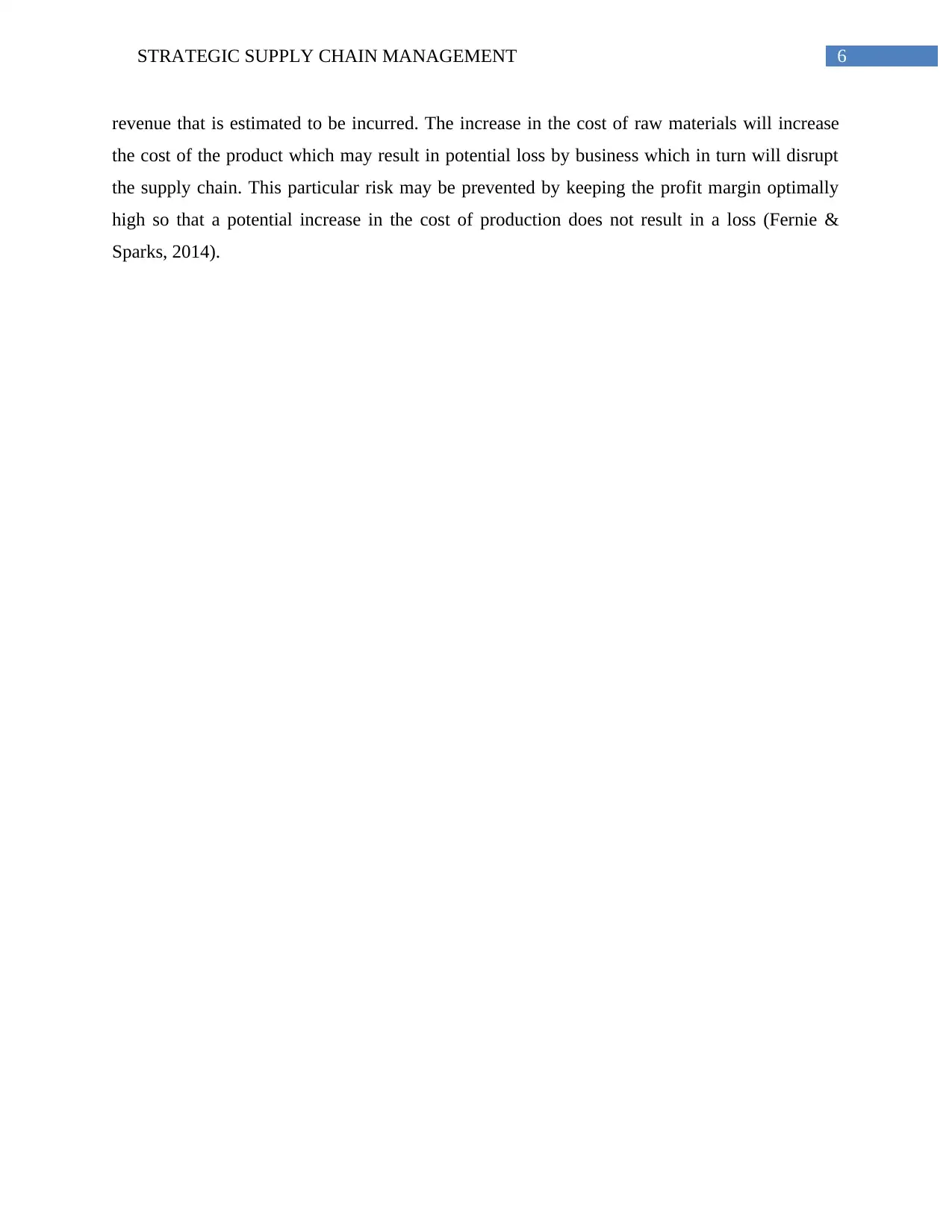
6STRATEGIC SUPPLY CHAIN MANAGEMENT
revenue that is estimated to be incurred. The increase in the cost of raw materials will increase
the cost of the product which may result in potential loss by business which in turn will disrupt
the supply chain. This particular risk may be prevented by keeping the profit margin optimally
high so that a potential increase in the cost of production does not result in a loss (Fernie &
Sparks, 2014).
revenue that is estimated to be incurred. The increase in the cost of raw materials will increase
the cost of the product which may result in potential loss by business which in turn will disrupt
the supply chain. This particular risk may be prevented by keeping the profit margin optimally
high so that a potential increase in the cost of production does not result in a loss (Fernie &
Sparks, 2014).
Paraphrase This Document
Need a fresh take? Get an instant paraphrase of this document with our AI Paraphraser
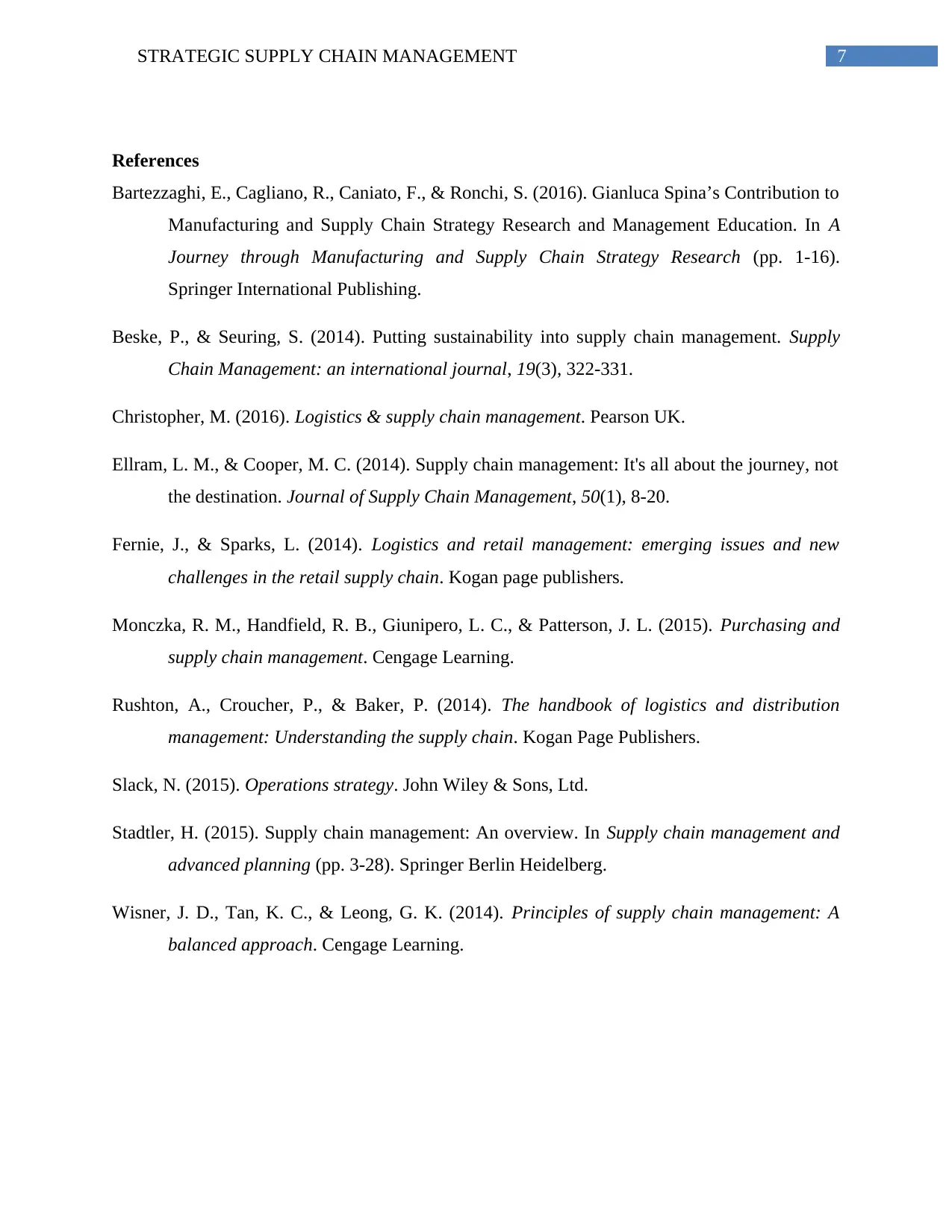
7STRATEGIC SUPPLY CHAIN MANAGEMENT
References
Bartezzaghi, E., Cagliano, R., Caniato, F., & Ronchi, S. (2016). Gianluca Spina’s Contribution to
Manufacturing and Supply Chain Strategy Research and Management Education. In A
Journey through Manufacturing and Supply Chain Strategy Research (pp. 1-16).
Springer International Publishing.
Beske, P., & Seuring, S. (2014). Putting sustainability into supply chain management. Supply
Chain Management: an international journal, 19(3), 322-331.
Christopher, M. (2016). Logistics & supply chain management. Pearson UK.
Ellram, L. M., & Cooper, M. C. (2014). Supply chain management: It's all about the journey, not
the destination. Journal of Supply Chain Management, 50(1), 8-20.
Fernie, J., & Sparks, L. (2014). Logistics and retail management: emerging issues and new
challenges in the retail supply chain. Kogan page publishers.
Monczka, R. M., Handfield, R. B., Giunipero, L. C., & Patterson, J. L. (2015). Purchasing and
supply chain management. Cengage Learning.
Rushton, A., Croucher, P., & Baker, P. (2014). The handbook of logistics and distribution
management: Understanding the supply chain. Kogan Page Publishers.
Slack, N. (2015). Operations strategy. John Wiley & Sons, Ltd.
Stadtler, H. (2015). Supply chain management: An overview. In Supply chain management and
advanced planning (pp. 3-28). Springer Berlin Heidelberg.
Wisner, J. D., Tan, K. C., & Leong, G. K. (2014). Principles of supply chain management: A
balanced approach. Cengage Learning.
References
Bartezzaghi, E., Cagliano, R., Caniato, F., & Ronchi, S. (2016). Gianluca Spina’s Contribution to
Manufacturing and Supply Chain Strategy Research and Management Education. In A
Journey through Manufacturing and Supply Chain Strategy Research (pp. 1-16).
Springer International Publishing.
Beske, P., & Seuring, S. (2014). Putting sustainability into supply chain management. Supply
Chain Management: an international journal, 19(3), 322-331.
Christopher, M. (2016). Logistics & supply chain management. Pearson UK.
Ellram, L. M., & Cooper, M. C. (2014). Supply chain management: It's all about the journey, not
the destination. Journal of Supply Chain Management, 50(1), 8-20.
Fernie, J., & Sparks, L. (2014). Logistics and retail management: emerging issues and new
challenges in the retail supply chain. Kogan page publishers.
Monczka, R. M., Handfield, R. B., Giunipero, L. C., & Patterson, J. L. (2015). Purchasing and
supply chain management. Cengage Learning.
Rushton, A., Croucher, P., & Baker, P. (2014). The handbook of logistics and distribution
management: Understanding the supply chain. Kogan Page Publishers.
Slack, N. (2015). Operations strategy. John Wiley & Sons, Ltd.
Stadtler, H. (2015). Supply chain management: An overview. In Supply chain management and
advanced planning (pp. 3-28). Springer Berlin Heidelberg.
Wisner, J. D., Tan, K. C., & Leong, G. K. (2014). Principles of supply chain management: A
balanced approach. Cengage Learning.
1 out of 8
Related Documents
Your All-in-One AI-Powered Toolkit for Academic Success.
+13062052269
info@desklib.com
Available 24*7 on WhatsApp / Email
![[object Object]](/_next/static/media/star-bottom.7253800d.svg)
Unlock your academic potential
Copyright © 2020–2025 A2Z Services. All Rights Reserved. Developed and managed by ZUCOL.





